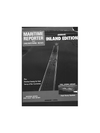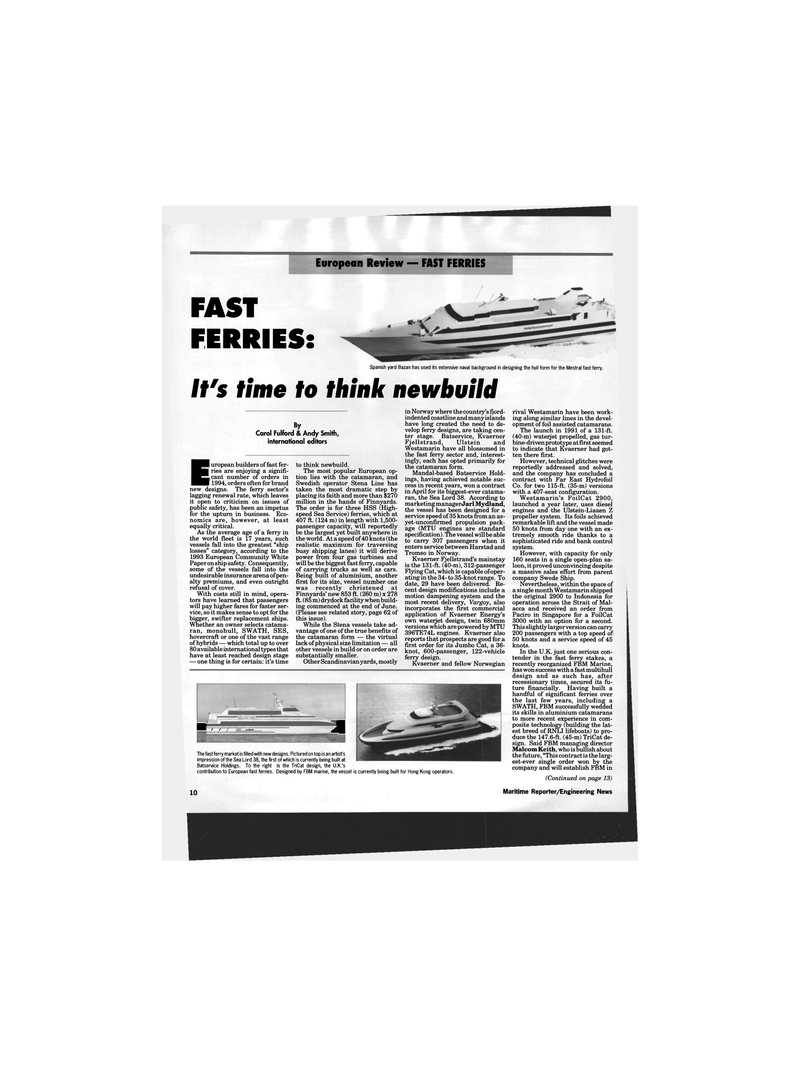
Page 6: of Maritime Reporter Magazine (August 1994)
Read this page in Pdf, Flash or Html5 edition of August 1994 Maritime Reporter Magazine
European Review — FAST FERRIES
FAST
FERRIES:
Spanish yard Bazan has used its extensive naval background in designing the hull form for the Mestral fast ferry.
It's time to think newbuild
By
Carol Fulford & Andy Smith, international editors
E uropean builders of fast fer-ries are enjoying a signifi-, cant number of orders in 1994, orders often for brand new designs. The ferry sector's lagging renewal rate, which leaves it open to criticism on issues of public safety, has been an impetus for the upturn in business. Eco- nomics are, however, at least equally critical.
As the average age of a ferry in the world fleet is 17 years, such vessels fall into the greatest "ship losses" category, according to the 1993 European Community White
Paper on ship safety. Consequently, some of the vessels fall into the undesirable insurance arena of pen- alty premiums, and even outright refusal of cover.
With costs still in mind, opera- tors have learned that passengers will pay higher fares for faster ser- vice, so it makes sense to opt for the bigger, swifter replacement ships.
Whether an owner selects catama- ran, monohull, SWATH, SES, hovercraft or one of the vast range of hybrids — which total up to over 80 available international types that have at least reached design stage — one thing is for certain: it's time to think newbuild.
The most popular European op- tion lies with the catamaran, and
Swedish operator Stena Line has taken the most dramatic step by placing its faith and more than $270 million in the hands of Finnyards.
The order is for three HSS (High- speed Sea Service) ferries, which at 407 ft. (124 m) in length with 1,500- passenger capacity, will reportedly be the largest yet built anywhere in the world. At a speed of 40 knots (the realistic maximum for traversing busy shipping lanes) it will derive power from four gas turbines and will be the biggest fast ferry, capable of carrying trucks as well as cars.
Being built of aluminium, another first for its size, vessel number one was recently christened at
Finnyards' new 853 ft. (260 m) x 278 ft. (85 m) dry dock facility when build- ing commenced at the end of June. (Please see related story, page 62 of this issue).
While the Stena vessels take ad- vantage of one of the true benefits of the catamaran form — the virtual lack of physical size limitation — all other vessels in build or on order are substantially smaller.
Other Scandinavian yards, mostly in Norway where the country's fjord- indented coastline and many islands have long created the need to de- velop ferry designs, are taking cen- ter stage. Batservice, Kvaerner
Fjellstrand, Ulstein and
Westamarin have all blossomed in the fast ferry sector and, interest- ingly, each has opted primarily for the catamaran form.
Mandal-based Batservice Hold- ings, having achieved notable suc- cess in recent years, won a contract in April for its biggest-ever catama- ran, the Sea Lord 38. According to marketing manager Jarl Mydland, the vessel has been designed for a service speed of 35 knots from an as- yet-unconfirmed propulsion pack- age (MTU engines are standard specification). The vessel will be able to carry 307 passengers when it enters service between Harstad and
Tromso in Norway.
Kvaerner Fjellstrand's mainstay is the 131-ft. (40-m), 312-passenger
Flying Cat, which is capable of oper- ating in the 34- to 35-knot range. To date, 29 have been delivered. Re- cent design modifications include a motion dampening system and the most recent delivery, Vargoy, also incorporates the first commercial application of Kvaerner Energy's own wateijet design, twin 680mm versions which are powered by MTU 396TE74L engines. Kvaerner also reports that prospects are good for a first order for its Jumbo Cat, a 36- knot, 600-passenger, 122-vehicle ferry design.
Kvaerner and fellow Norwegian
MRRL •••••!;!••• -as
The fast ferry market is filled with new designs. Pictured on top is an artists impression of the Sea Lord 38, the first of which is currently being built at
Batservice Holdings. To the right is the TriCat design, the U.K.'s contribution to European fast ferries. Designed by FBM marine, the vessel is currently being built for Hong Kong operators. rival Westamarin have been work- ing along similar lines in the devel- opment of foil assisted catamarans.
The launch in 1991 of a 131-ft. (40-m) wateijet propelled, gas tur- bine-driven prototype at first seemed to indicate that Kvaerner had got- ten there first.
However, technical glitches were reportedly addressed and solved, and the company has concluded a contract with Far East Hydrofoil
Co. for two 115-ft. (35-m) versions with a 407-seat configuration.
Westamarin's FoilCat 2900, launched a year later, uses diesel engines and the Ulstein-Liaaen Z propeller system. Its foils achieved remarkable lift and the vessel made 50 knots from day one with an ex- tremely smooth ride thanks to a sophisticated ride and bank control system.
However, with capacity for only 160 seats in a single open-plan sa- loon, it proved unconvincing despite a massive sales effort from parent company Swede Ship.
Nevertheless, within the space of a single month Westamarin shipped the original 2900 to Indonesia for operation across the Strait of Mal- acca and received an order from
Paciro in Singapore for a FoilCat 3000 with an option for a second.
This slightly larger version can carry 200 passengers with a top speed of 50 knots and a service speed of 45 knots.
In the U.K. just one serious con- tender in the fast ferry stakes, a recently reorganized FBM Marine, has won success with a fast multihull design and as such has, after recessionary times, secured its fu- ture financially. Having built a handful of significant ferries over the last few years, including a
SWATH, FBM successfully wedded its skills in aluminium catamarans to more recent experience in com- posite technology (building the lat- est breed of RNLI lifeboats) to pro- duce the 147.6-ft. (45-m) TriCat de- sign. Said FBM managing director
Malcom Keith, who is bullish about the future, "This contract is the larg- est-ever single order won by the company and will establish FBM in (Continued on page 13) 10 Maritime Reporter/Engineering News

 5
5

 7
7
